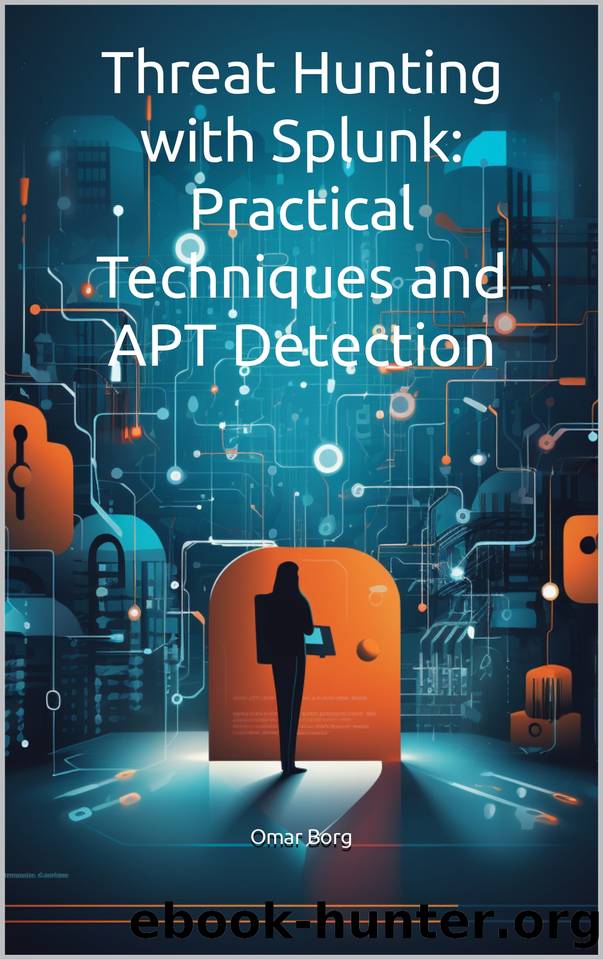Threat Hunting with Splunk: Practical Techniques and APT Detection by Borg Omar

Author:Borg, Omar
Language: eng
Format: epub
Publisher: Omar Borg
Published: 2023-09-11T00:00:00+00:00
Chapter 7.1: Incident Response and Remediation with Yara Rules
In this expanded chapter, we will delve into the integration of Yara rules into your incident response and remediation processes using Splunk. Yara is a powerful tool for identifying and classifying malware and suspicious files based on patterns and characteristics. By incorporating Yara rules, you can enhance your incident response capabilities, especially when dealing with malware-related incidents.
7.1 The Incident Response Process
Before we explore the integration of Yara rules, let's revisit the incident response process, which includes the following phases:
Preparation: Develop an incident response plan, establish communication channels, and identify critical assets.
Identification: Detect and classify security incidents through monitoring, alerts, and analysis.
Containment: Isolate and prevent further damage or unauthorized access.
Eradication: Identify and eliminate the root cause of the incident.
Recovery: Restore affected systems and services to normal operation.
Lessons Learned: Conduct a post-incident review to improve future responses.
7.2 Leveraging Yara Rules in Incident Response
Yara is a widely-used open-source tool for identifying and classifying malware based on patterns, characteristics, and behavioral indicators. Integrating Yara rules into your incident response process can be highly beneficial:
Yara Rule Creation: Security teams can create custom Yara rules to detect specific malware families or behaviors relevant to their organization.
Real-time Monitoring: Splunk can be configured to continuously monitor logs and data for matches with Yara rules, allowing for immediate detection of potentially malicious files or behavior.
Alerting: Custom alerts in Splunk can be triggered when Yara rules identify files or activities that match known malware characteristics.
Automated Actions: Upon detecting malware with Yara rules, automated actions can be initiated, such as isolating affected systems, blocking network traffic, or initiating malware removal procedures.
Incident Documentation: Splunk can be used to document the entire incident response process, including the use of Yara rules, providing a comprehensive audit trail.
7.3 Case Study: Using Yara Rules for Malware Detection
Let's explore a case study that illustrates the use of Yara rules in incident response:
Scenario: An organization detects unusual file behavior on a critical server, suspecting a malware infection. The incident response team uses Yara rules integrated with Splunk to identify and remediate the malware.
Identification:
Splunk generates an alert based on suspicious file behavior detected in server logs.
The incident response team creates a custom Yara rule to identify files associated with the suspected malware.
Real-time Monitoring and Alerting:
Splunk continuously monitors file activities and triggers alerts when the custom Yara rule matches potentially malicious files.
Containment and Eradication:
Upon an alert, automated actions are initiated to isolate the affected server from the network.
The incident response team uses Splunk to search for files that triggered the Yara rule and confirms the presence of malware.
Recovery:
Affected systems are taken offline and cleaned.
Malicious files are removed, and systems are restored from known clean backups.
Lessons Learned:
The incident response team reviews the incident and updates the Yara rule library with new indicators of compromise (IoCs) from the malware infection.
Additional Yara rules are created to proactively detect similar threats in the future.
7.4 Yara Rule Best Practices
When using Yara rules in incident response, consider the following best practices:
Regularly update Yara rules to include the latest IoCs and malware characteristics.
Download
This site does not store any files on its server. We only index and link to content provided by other sites. Please contact the content providers to delete copyright contents if any and email us, we'll remove relevant links or contents immediately.
| Cryptography | Encryption |
| Hacking | Network Security |
| Privacy & Online Safety | Security Certifications |
| Viruses |
Effective Threat Investigation for SOC Analysts by Yahia Mostafa;(7462)
Practical Memory Forensics by Svetlana Ostrovskaya & Oleg Skulkin(7182)
Machine Learning Security Principles by John Paul Mueller(7139)
Attacking and Exploiting Modern Web Applications by Simone Onofri & Donato Onofri(6812)
Operationalizing Threat Intelligence by Kyle Wilhoit & Joseph Opacki(6779)
Solidity Programming Essentials by Ritesh Modi(4568)
Microsoft 365 Security, Compliance, and Identity Administration by Peter Rising(4162)
Operationalizing Threat Intelligence by Joseph Opacki Kyle Wilhoit(3911)
Learn Computer Forensics - Second Edition by William Oettinger(3652)
Building a Next-Gen SOC with IBM QRadar: Accelerate your security operations and detect cyber threats effectively by Ashish M Kothekar(3640)
Future Crimes by Marc Goodman(3566)
Blockchain Basics by Daniel Drescher(3544)
Mastering Azure Security by Mustafa Toroman and Tom Janetscheck(3514)
Mastering Python for Networking and Security by José Manuel Ortega(3475)
Incident Response with Threat Intelligence by Roberto Martínez(3384)
The Code Book by Simon Singh(3142)
Mastering Bitcoin: Programming the Open Blockchain by Andreas M. Antonopoulos(3015)
Mobile App Reverse Engineering by Abhinav Mishra(2981)
From CIA to APT: An Introduction to Cyber Security by Edward G. Amoroso & Matthew E. Amoroso(2891)
